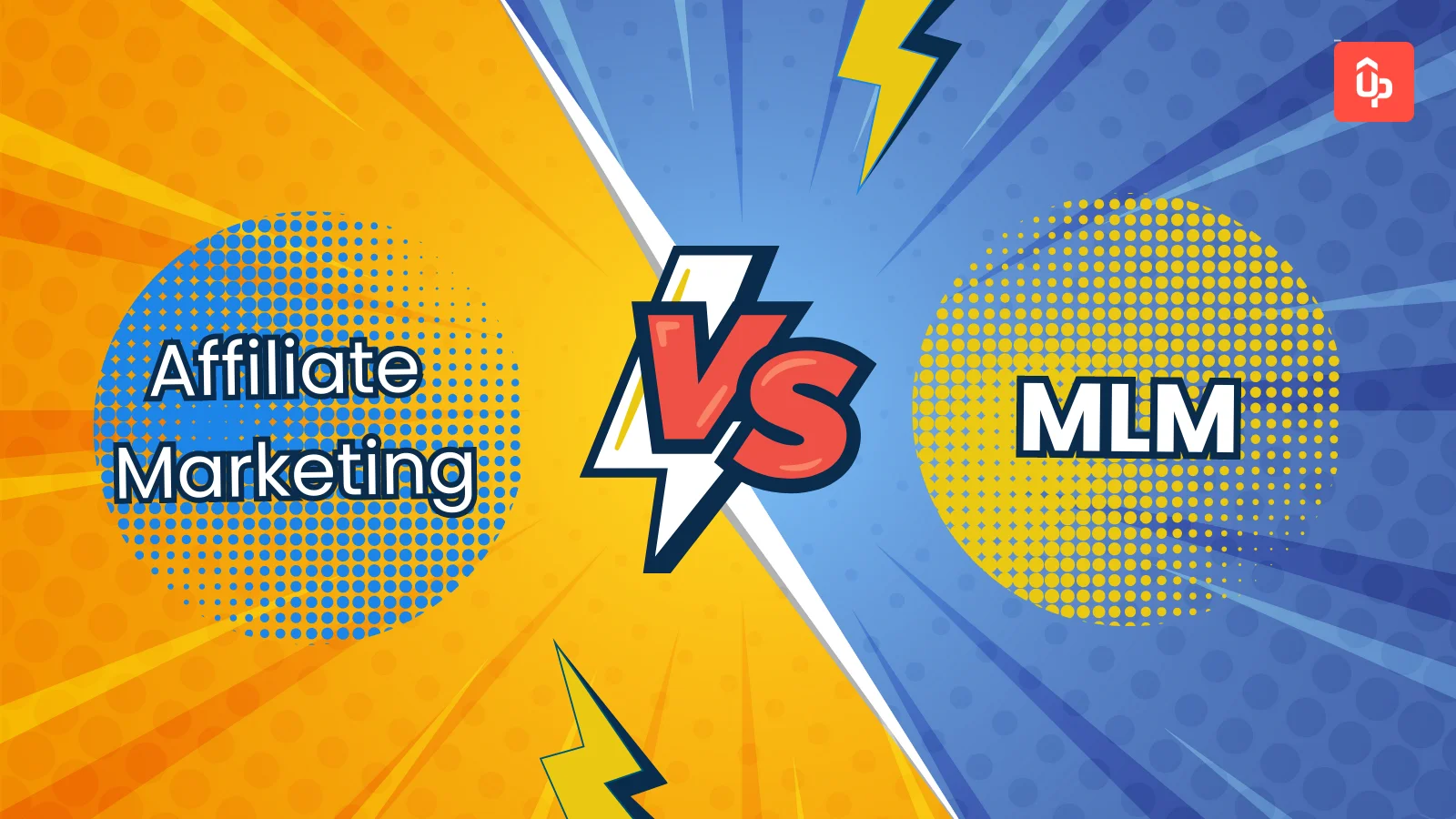At first glance, affiliate marketing and multi-level marketing (MLM) seem quite similar. They both require others to sell for you. You then cut down a piece of profit to pay the ones that bring you sales. And lastly, these two marketing avenues existed and succeeded even before the age of eCommerce.
Yet, affiliate marketing and multi-level marketing are two distinctive avenues with differences in in the way they operate, the sources of revenue, the structure of commission payments, the costs to join, and more.
Let’s dive in and find out which one is more suitable for your business!
TL;DR
- Explore affiliate marketing: its definition and how it works
- Understand the basics of Multi-level marketing (MLM)
- Discover what is the difference between MLM and affiliate marketing
- Determine which solution is optimal for your business between the two models
- Is it possible to combine MLM with affiliate marketing? We will provide you with the answer.
- Want to add the strength of MLM to your affiliate programs? Use UpPromote, the #1 Shopify affiliate software trusted by experts and 115,000+ global customers, to expand your affiliate network.
Turn on UpPromote’s robust settings and grow your affiliate base via MLM recruiting.
Overview of Affiliate Marketing
Over 80% of companies worldwide use affiliate marketing to boost sales and brand awareness. To decide whether to use this method or not, you first need to have a thorough understanding of affiliate marketing. Knowing how it works will help you see if it fits your needs.
What is Affiliate Marketing?
Affiliate marketing is a performance-based strategy. You work with individuals, called affiliates, to sell your products. You pay them commissions for each sale from their affiliate links or coupon codes to your store.
Types of affiliates you can team up with include bloggers, influencers, and reviewers.
Here’s a breakdown of how affiliate marketing works:
- Create an affiliate campaign: As a merchant, you set up an affiliate program. Outline the terms, conditions, and commission structure for affiliates.
- Recruit affiliates: Encourage publishers to sign up for your program and agree to promote your products.
- Provide promotion tools: Offer affiliates unique tracking links or codes to use in their advertising activities (e.g., placing on websites, sharing on social media accounts, etc.).
- Monitor customer action: Track when a customer clicks on the affiliate’s link or uses their coupon code and completes a desired action (such as making a purchase).
- Track affiliate performance: Utilize cookies or other tracking methods to ensure accurate reporting of affiliate promotional results.
- Pay commissions: Reward the affiliate with a commission based on the agreed-upon terms (percentage of the sale, fixed amount per item, etc.).
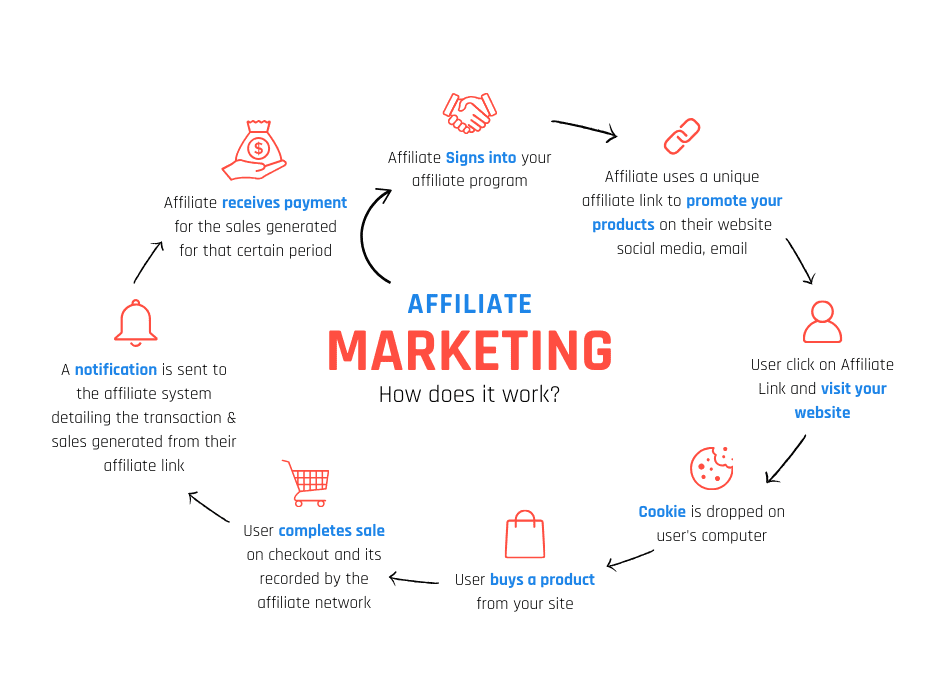
Affiliate Marketing Pros and Cons
Now, you have a clearer picture of affiliate marketing’s definitions and operations. However, everything needs to be considered on both sides of the coin. Take a quick look at the table:
|
Pros |
Cons |
|
Multi-billion dollar industry |
High competition |
|
Cost-effectiveness and low financial risk |
Dependence on the affiliate performance |
|
Ability to scale |
Fraud and abuse |
|
Access to a larger audience |
Risk of brand misrepresentation |
|
No need for a large in-house sales team |
Time and effort required |
|
Flexibility |
Risk of disputes with affiliates |
In fact, affiliate marketing has blossomed into a booming industry, now worth over $17 billion (as of 2023. And it doesn’t stop there—experts are saying that by 2030, this number could skyrocket to $40 billion.
So, why do so many brands love affiliate marketing? It’s simple: it’s a performance-based approach, which means you only pay commissions for actual sales or leads brought in by your affiliates. This gives you the freedom to create a variety of programs and invite as many partners as you like without worrying about a significant increase in costs.
What’s even better is teaming up with bloggers or influencers who already have loyal followers. They can help you tap into new markets and reach customers you might not have been able to reach on your own. These affiliates can use blogs, social media, email marketing, and other channels to spread the word about your products, driving more referrals and boosting your brand’s visibility.
However, there are still some drawbacks you might want to keep in mind:
- With over 80% of businesses using affiliate marketing (Rakuten), it’s no surprise that the market is crowded. Standing out in such a busy space can be a real challenge.
- Your affiliate program’s success depends on how well your affiliates perform. If they’re not putting in the effort, your program might not see the results you’re hoping for.
- Managing affiliates can be a bit time-consuming. It takes effort to keep track of their performance and make sure they’re following your guidelines. And let’s face it: some affiliates might try to game the system with self-clicking or bots to generate fake traffic. Thankfully, there’s affiliate management software that can help you overcome these scams and ensure everything runs smoothly.
- There’s also the risk that affiliates might not always represent your brand the way you’d like, which could harm your reputation.
- Any mistakes in the workflow, especially when it comes to payments or tax deductions, can lead to misunderstandings or conflicts, which could end your collaboration with affiliates.
Case Study: Successful Examples of Affiliate Marketing
One successful brand that uses affiliate marketing is Amazon with its Amazon Associates program.
Launched in 1996, Amazon Associates is one of the largest and most well-known affiliate programs globally. Affiliates, including website owners, bloggers, and social media influencers, can earn commissions by promoting Amazon products and driving sales through their unique affiliate links.
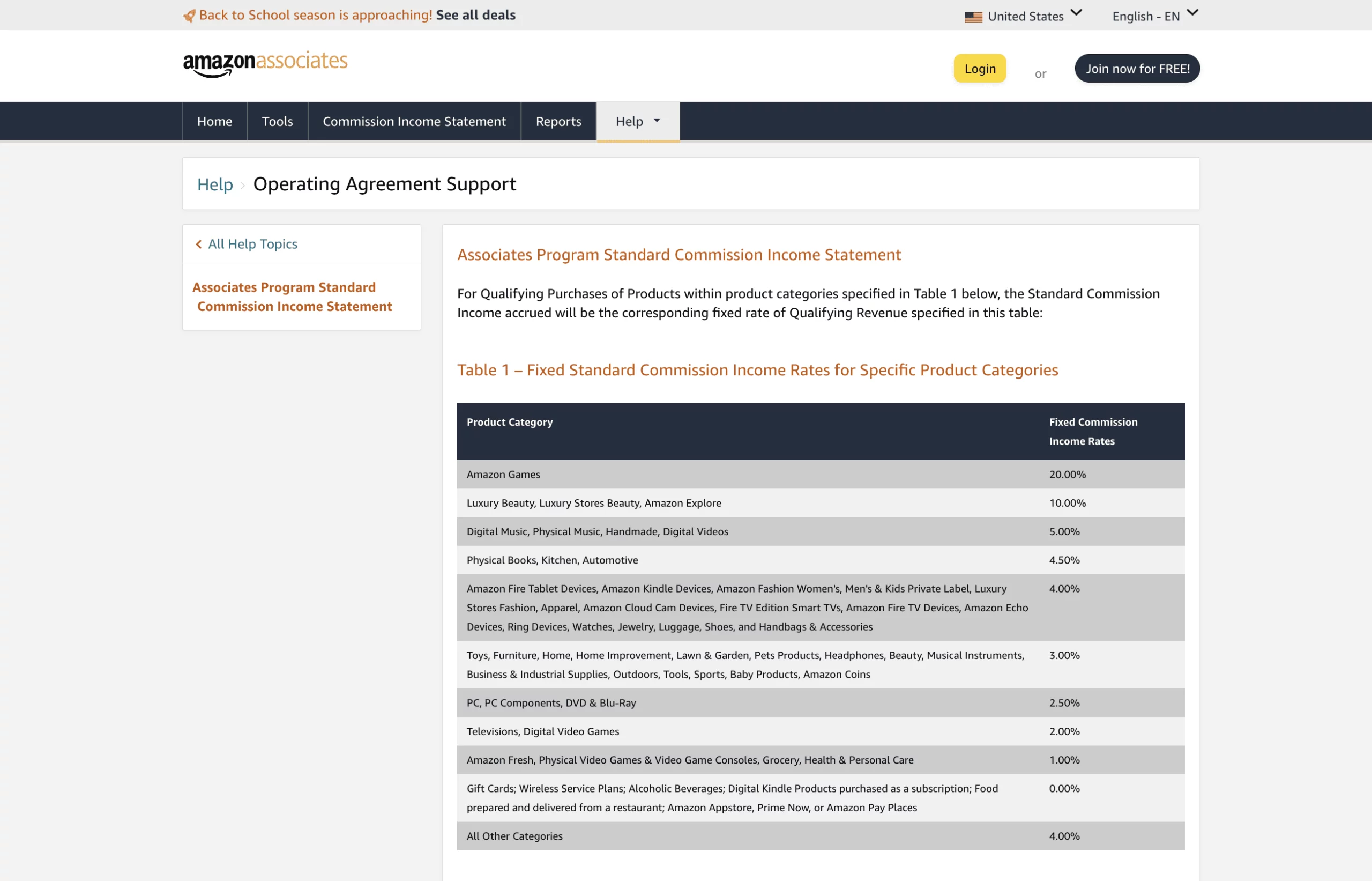
Amazon offers commission rates ranging from 1% to 20%, depending on the product category. This flexibility allows publishers to easily choose from millions of products to promote to their target audience.
With over 900,000 affiliates worldwide, the Amazon Associates program plays a key role in boosting Amazon’s sales and revenue. In Q1 2024, Amazon’s net revenue was $143.3 billion. Its affiliate marketing efforts contributed significantly to this.

For another success story with affiliate marketing, check out TréSkin. It’s a top organic beauty brand in the USA. They specialize in aloe vera-based skin care, haircare, and wellness products.

To grow their business, TréSkin decided to prioritize affiliate marketing over traditional advertising and marketing methods.
The brand works with UpPromote, the top-recommended affiliate solution on Shopify, to customize multiple programs for different-level affiliates with lucrative commissions. By doing that, TréSkin can attract high-performance ambassadors in the industry to promote their products.
They also use UpPromote Marketplace to find new potential affiliates. It helps them grow their network and boost sales.
Only within a quarter of running an affiliate marketing campaign through UpPromote, Tréskin witnessed significant sales and acquired over $120,000 in affiliate revenue.
Jumpstart your affiliate marketing with UpPromote and launch your program in just 5 minutes!
Overview of MLM (Multi-Level Marketing)
To compare affiliate marketing vs multi-level marketing (MLM), learn the MLM definition, how it works, and its pros and cons.
What is Multi-level Marketing?
MLM stands for Multi-level marketing. It is also known as network marketing or referral marketing.

MLM relies on a network of distributors to grow the business. In this model, people sell products or services directly to customers and encourage others to join and sell the same products or services.
Here are the key features of MLM:
- Direct Sales: Distributors sell products directly to consumers, often through personal relationships and word-of-mouth.
- Hierarchical structure: MLM businesses are typically structured with each distributor at the top earning a commission on the sales of the people they recruit.
- Recruitment: Distributors are encouraged to expand the network by bringing in new members.
- Commissions: Distributors earn commissions from their own sales and the sales made by the recruit’s downline.
MLM Pros and Cons
Now, you have a basic understanding of what MLM is and how this model operates. Let’s dig deeper to explore its benefits and drawbacks:
|
Pros |
Cons |
|
Network expansion: Distributors use their networks to reach new markets. |
Reputation risks: MLMs often face negative views and comparisons to illegal pyramid schemes. This harms their brand reputation. |
|
High sales potential: Each distributor’s drive to earn can boost sales. |
Income inequality & high turnover: Lower-tier distributors earn less. Those who don’t earn much may leave the program quickly. |
|
Personal touch in sales: Direct selling can boost loyalty and satisfaction. It relies on personal relationships. |
High training and support costs: Organizing training, creating materials, and using resources to teach distributors about the products, and sales methods, whether in-person or online, incurs expenses. |
|
Low operational costs: Distributors handle inventory and logistics, reducing the merchant’s burdens. |
Complex management: Managing a large, distributed sales team is hard and resource-intensive. |
|
Community building: It creates loyalty among distributors. This can boost their motivation. |
Overemphasis on recruitment: There’s a risk that the focus can shift from the quality of the products to just recruiting and growing the distributor network. Plus, new participants are often asked to make a big initial investment, usually by buying in and purchasing products at a discount to join. |
Case Study: Successful Examples of MLM
MLM is one of the good business models that boost product sales and thereby establish the brand.
If you’re looking for examples of top MLM or network marketing companies, Amway is one of the outstanding names. Established in 1959, it is a global leader in the MLM industry. The firm mainly sells lifestyle and health-related products.
Amway’s success with the MLM model is clear. It operates in over 100 countries and provides strong support and training for its Independent Business Owners (IBOs). In 2023, Amway’s revenue was $7.7 billion. This shows its MLM strategy drove strong sales and market presence.

Another successful MLM company is Herbalife. Founded in 1980, the brand focuses on nutrition, weight management, and personal care products.
Herbalife has used the MLM model to build a large network of Independent Herbalife Members in over 90 countries. The company’s focus on health and wellness, plus smart marketing and training, has led to its success. In 2023, Herbalife made $5.1 billion in revenue, showing how powerful its MLM approach is.

Key Differences Between Affiliate Marketing vs MLM
Now that you have an idea of the basics of MLM vs affiliate marketing. You might wonder: Is affiliate marketing an MLM? The answer is no. Let’s take a look at the differences between network marketing and affiliate marketing.
Simply put, the key difference lies in the business structure and revenue generation methods. Affiliate marketing involves promoting your products through affiliates who earn commissions on sales. Meanwhile, MLM requires building a sales team where your sales force isn’t just selling – they’re also signing up more sellers.
Here are some main points you should keep in mind when comparing MLM to affiliate marketing:
|
Differences |
Affiliate marketing |
MLM |
|
Business model |
Team up with affiliates to promote products and pay them commissions for bringing sales or leads. |
Emphasizes recruitment. Earning from products/services promotion of distributors’ sales and recruits’ sales. |
|
Structure of the sales team |
All affiliates receive the same treatment. The affiliate brings sales, and you pay the agreed-upon commission. A performance-based reward is optional. |
You build a hierarchical structure where recruits can bring in more sellers to help drive sales. In this model, the top recruiters get more shares while their downlines get crumbs. |
|
Revenue source |
Your revenue comes from sales and leads generated by affiliates’ marketing efforts. |
Your revenue comes from personal sales and the sales generated by your recruits at various levels. |
|
Commission structure |
You typically offer a fixed commission or a percentage of sales to affiliates. |
You provide a complex commission structure involving bonuses, incentives, and earnings from recruitment. |
|
Enrollment free |
Affiliates are free to join different programs. They can start promoting the brand’s products and earning commissions right away. |
Participants have to invest a lot of money to get started, including the cost of starter kits, inventory purchases, and fees for attending training sessions. |
MLM vs Affiliate Marketing – Which is Better?
It’s tough to say which is better: multi-level marketing or affiliate marketing. It depends on your preferred business strategy and goals. Both approaches let you make money by promoting and selling products. But they operate in distinct ways.
Affiliate marketing could be more suitable if you want a simpler, more direct way to boost sales through individual promoters. Meanwhile, you can choose MLM in case you prefer a team-based approach and are prepared to invest in extensive training and support.
In other words, MLM is more complex due to its hierarchical structure, extensive recruitment and training requirements, and intricate commission plans. Affiliate marketing is easier to manage, making it a more straightforward option for your business.
You might question: Is affiliate marketing a pyramid scheme? Definitely not. You’re primarily focused on selling products, not building a team.
In contrast, controversies arise when MLM leans too hard on the recruit-to-earn model. This makes MLM easily mistaken for a pyramid scheme, which focuses more on recruitment than actual sales. In such schemes, the top members often earn most of the money, while new recruits get very little.
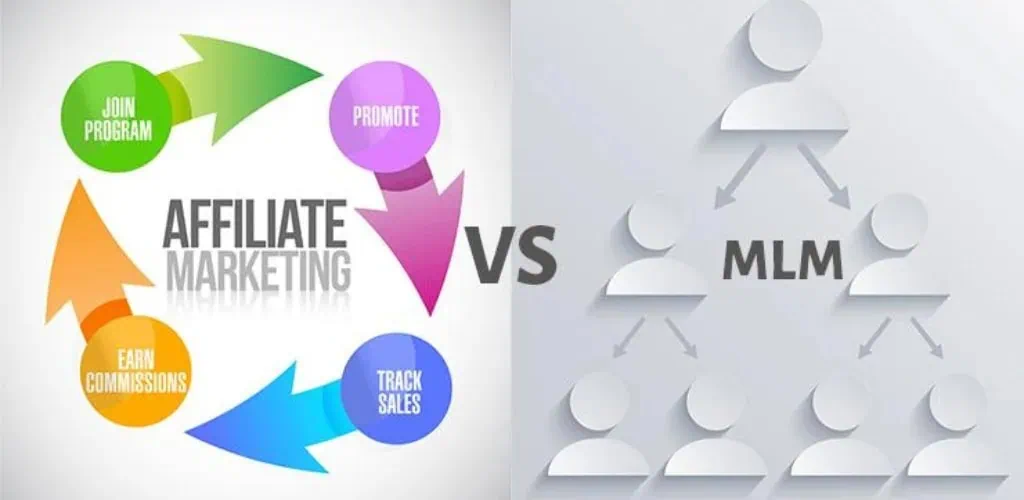
Choosing between affiliate marketing vs network marketing (MLM) for your business is entirely up to you. However, affiliate marketing is likely a better choice for several reasons: it is easy to start & manage, sales-focused and protects your brand reputation from negative perceptions associated with pyramid schemes.
Can You Combine MLM with Affiliate Marketing?
It might sound surprising, but the answer is yes.
Affiliate marketing and MLM are different. So, most people apply them separately to their businesses.
But what if you could run affiliate programs while also harnessing MLM’s strengths to grow your affiliate team and expand your brand’s reach?
One thing you can borrow from MLM for your affiliate program is creating a tiered reward system. This doesn’t mean turning the affiliate marketing model into an MLM scheme. Instead, it involves rewarding affiliates not only for their own sales or leads but also for the performance of new members they bring into the campaign.
This strategy will encourage your existing ambassadors to invite others to be their downlines for higher commissions. In other words, it can be an effective way to look for new affiliate marketers.
Simultaneously, you can keep your current affiliates engaged and motivated by offering them additional income opportunities. The first type is a commission for each order they refer to. The second type is a network commission, which depends on the sales made by their downline distributors.
Employing the power of the MLM model is part of Saledress’s smart affiliate marketing strategy. This plan helps the international online fashion clothing brand successfully attract more affiliates to promote its products.

Saledress uses UpPromote, the top-rated affiliate software on Shopify, featuring a 4.9/5 rating and over 4,000 reviews, to build a commission network. They reward affiliates for each new sign-up they bring in. This approach encourages both direct sales and the expansion of the affiliate team.
Saledress saw great results with UpPromote. In 2022, they made over $1.8 million in affiliate marketing revenue. With around 5,000 affiliates, they brought in more than 30,000 orders in just 1.5 years.
Want to duplicate Saledress’s success? Try UpPromote for FREE today.
Note: It is possible to combine Multi Level Marketing (MLM) with affiliate marketing. However, you need a careful plan to ensure it works effectively and stays compliant with regulations. Here’s the thing you should keep in mind for combining the two models:
-
Find the right balance for your affiliate program. Ensure that recruitment is a side benefit, not the core of your marketing strategy
-
In the MLM model, the goal is often to recruit as many new members as possible. But in affiliate marketing, it’s important to focus on quality over quantity. Choose affiliates who truly fit your brand and can promote your products well.
How to Combine Mlm With Affiliate Marketing Using Uppromote?
Combining MLM with affiliate marketing might seem daunting without the right system in place. That’s where UpPromote comes in—the all-in-one referral and affiliate marketing software on Shopify. Its robust features help you blend both models smoothly, leveraging the strengths of MLM to boost your affiliate program while keeping everything organized and efficient.
Install UpPromote & activate the power of MLM to build a large team of brand advocates.
With UpPromote’s Multi-level Marketing feature, you can set separate MLM rules for each campaign.
To activate the Multi-level marketing, go to Outreach > Affiliate recruitment > Multi-level marketing. Select the program and Activate MLM. Then, determine which program you want to apply and calculate network commissions based on total sales or program commissions.
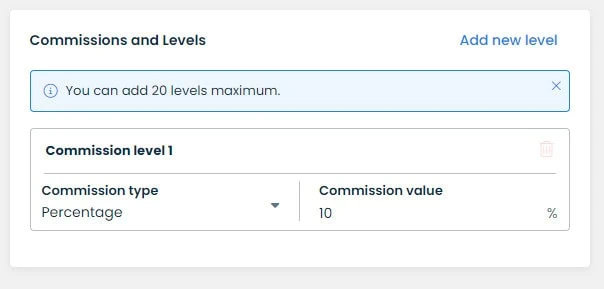
Our platform lets you add 20 levels with commissions for your MLM network. To help you understand, we provide a live example. It shows how to calculate MLM commissions exactly.
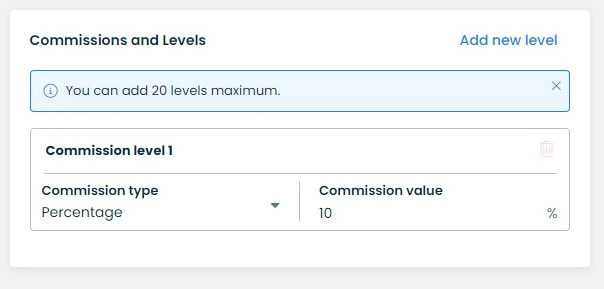
Imagine that: John becomes your affiliate and invites Victor. Victor then invites Michelle. Next, Michelle recruits David.
If David brings in a referral order totaling $1000 and the commission percentage for the affiliate program is set at 10%, he will earn a commission of 10% x $1000 = $100. Other publishers at higher levels will receive network commissions as follows:
-
Commission level 1 (Michelle, who recruits David) receives 5%.
-
Commission level 2 (Victor, who recruits Michelle) receives 4%.
-
Commission level 3 (John, who recruits Victor) receives 2%.
You can set the network commission in two ways: program commission or total sales. The calculation in the live example section can help you decide which is better for your affiliate program.
Here are the results for your consideration:
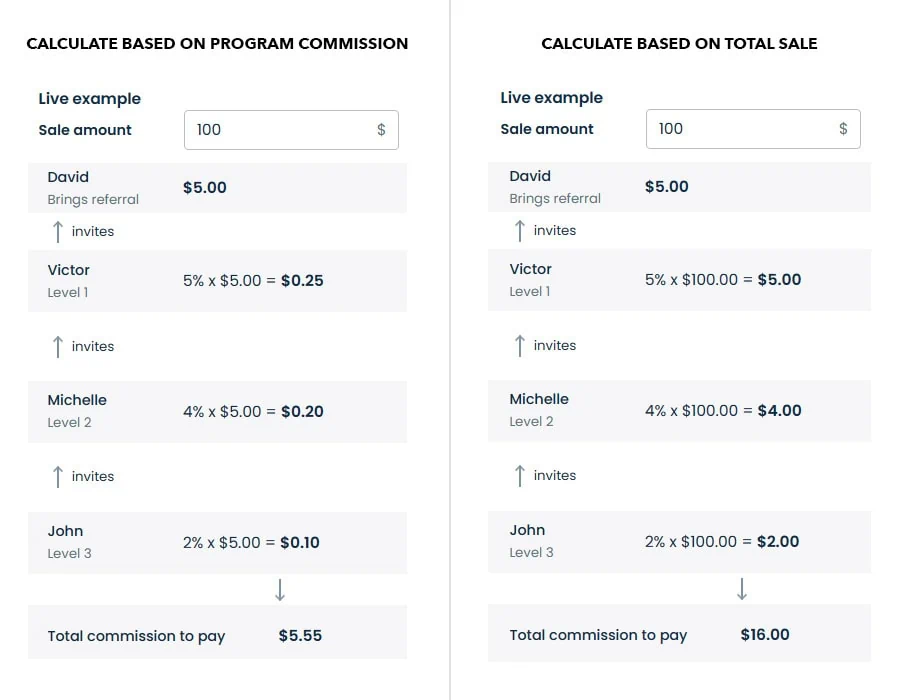
Then, select the best commission structure for your goal. It can either maximize the amount paid to affiliates or encourage them to recruit more team members.
With UpPromote, you can add a recruitment bonus for your affiliates using the Recruitment Bonus option.
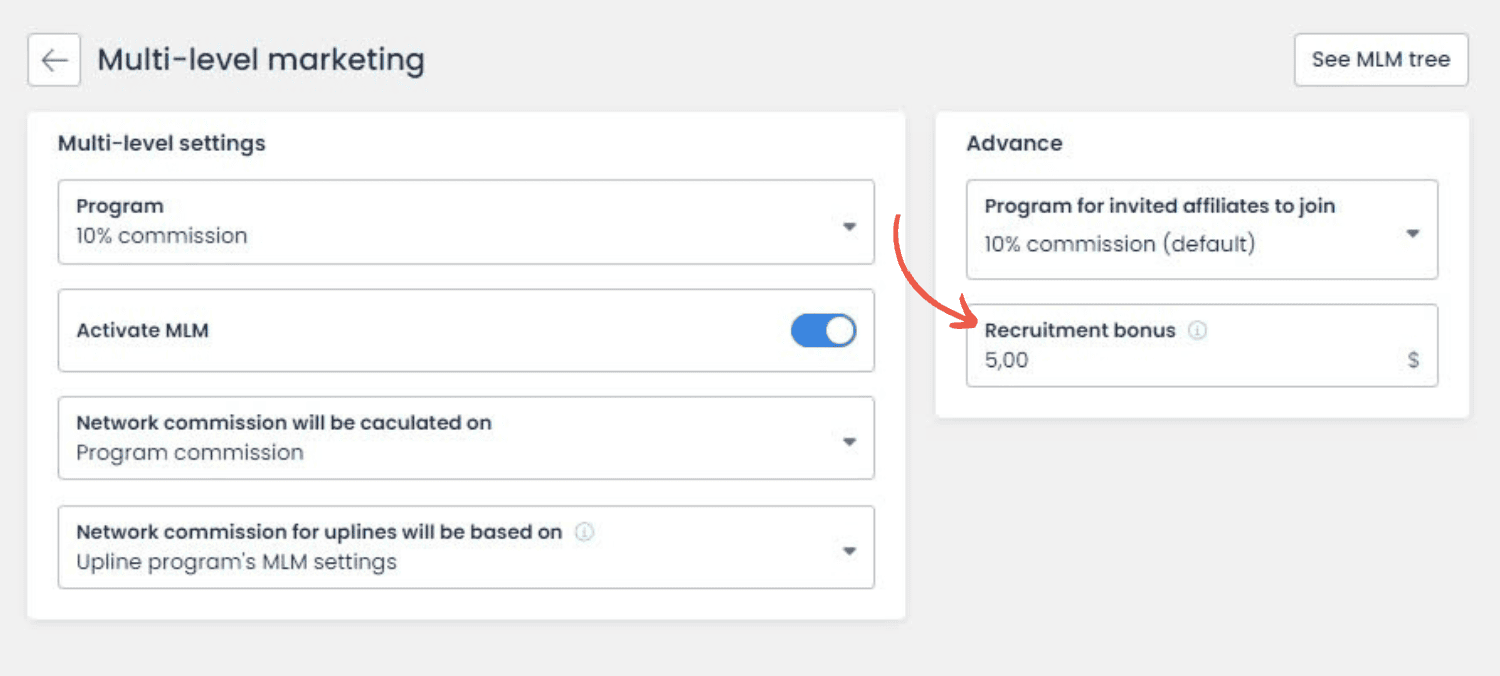
This bonus will be given as a new referral when the newly recruited affiliate is approved.

When you turn on the MLM feature in a program, each existing affiliate will have a network link to invite others. Your partners can find it right on their affiliate account’s dashboard.
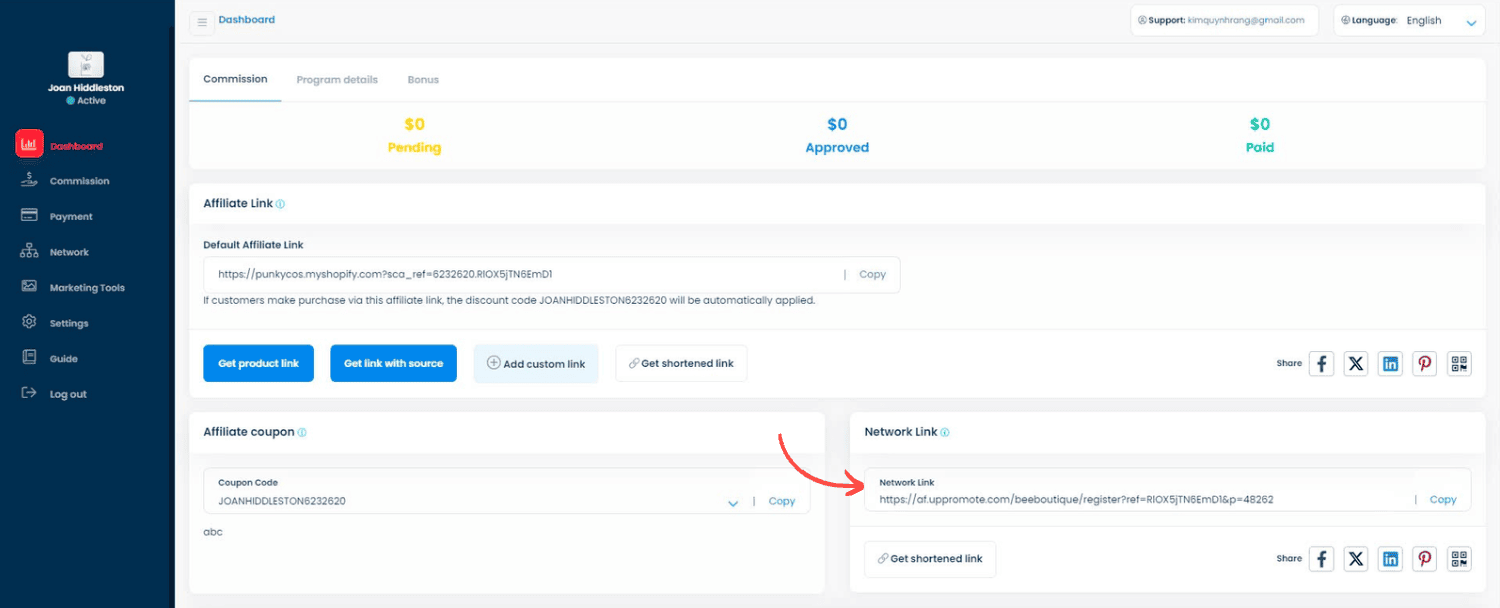
For easy management, click See MLM tree. It shows a visual of the affiliates’ relationships in the MLM network.
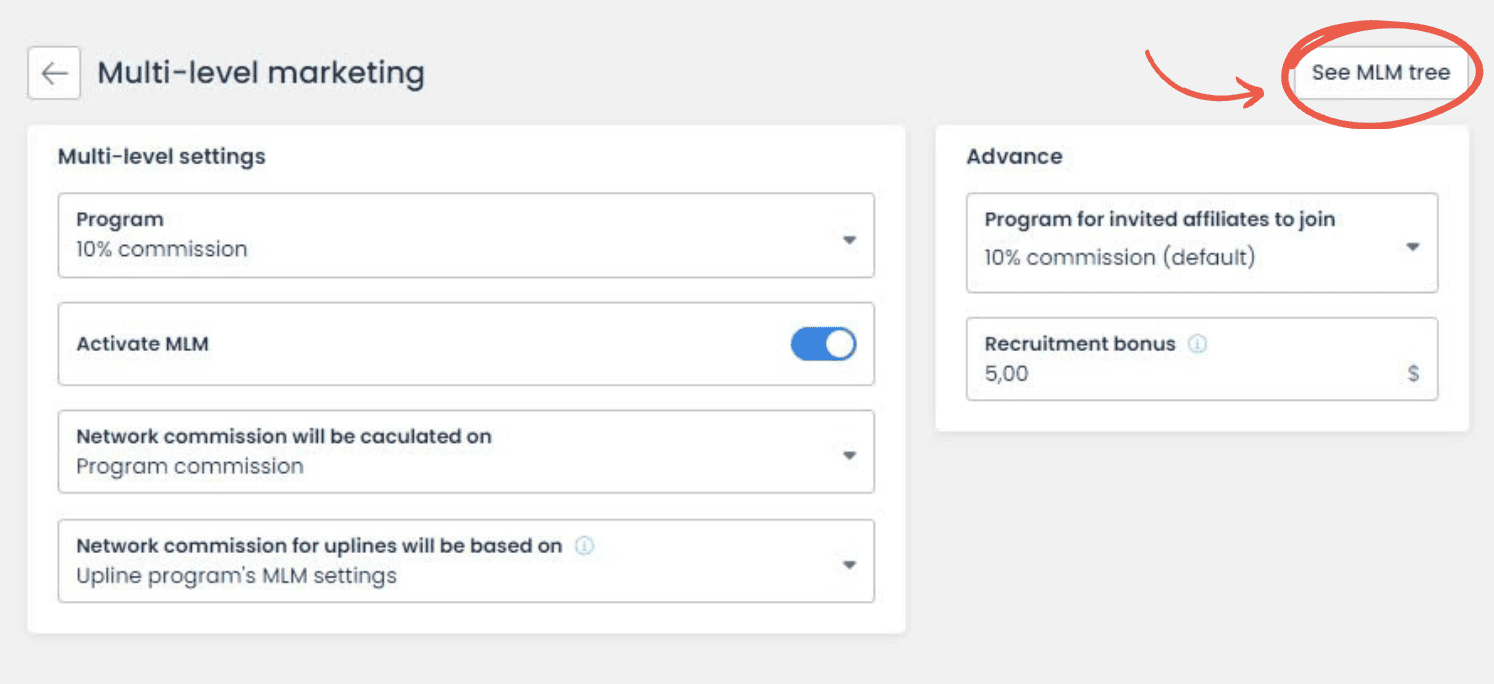
On the See MLM tree page, you will see the Network list to view an affiliate’s uplines and downlines. Any affiliate with a downline will get a Plus icon, so you can click on it to see it. Here’s an example:
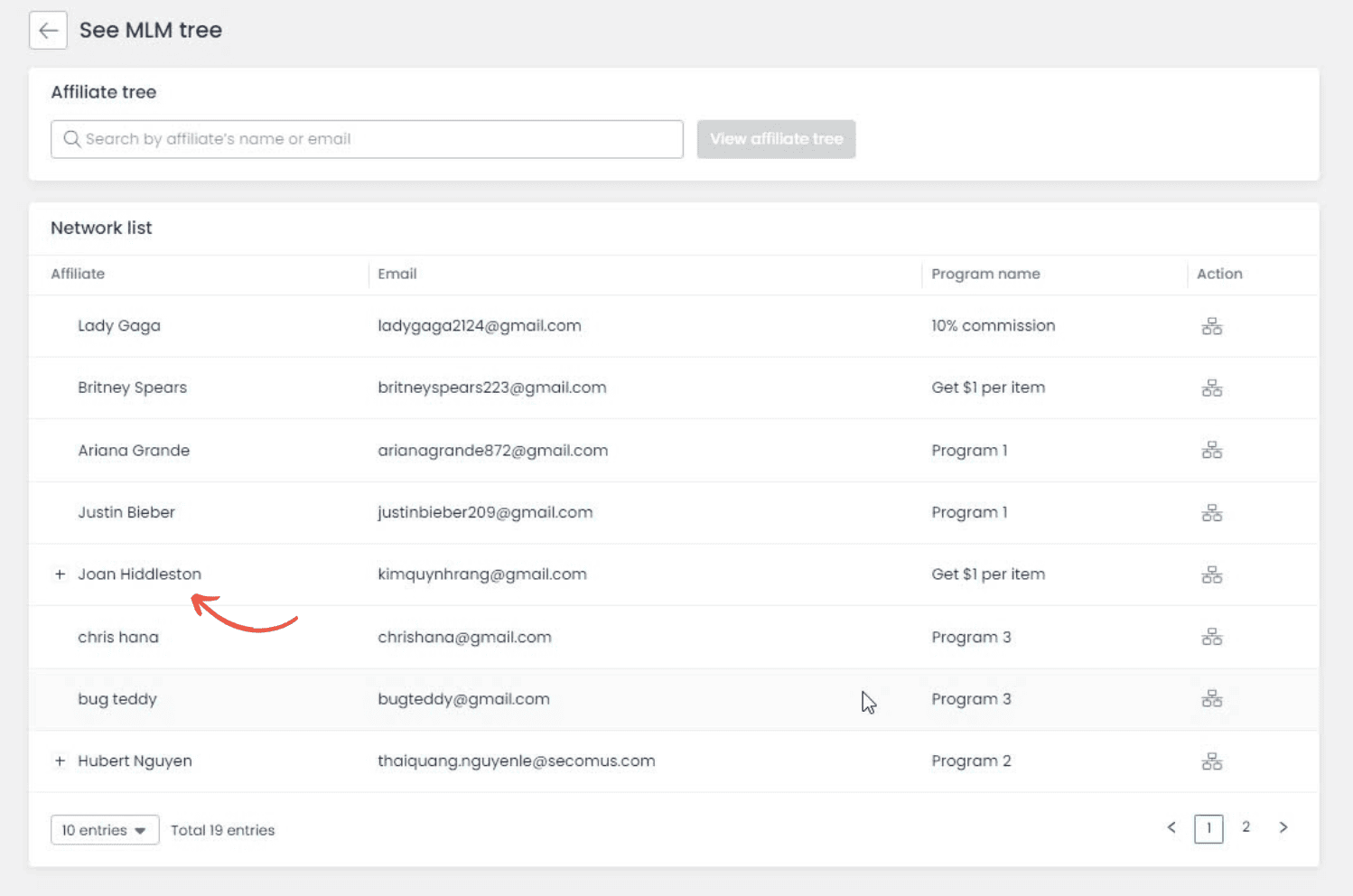
You can also view an affiliate’s MLM tree via the visual board by clicking on the icon in the Action column. Or, you can search for and choose an affiliate, then click View affiliate tree. Next, the visual board opens to show you the selected affiliate’s uplines and downlines (if any).
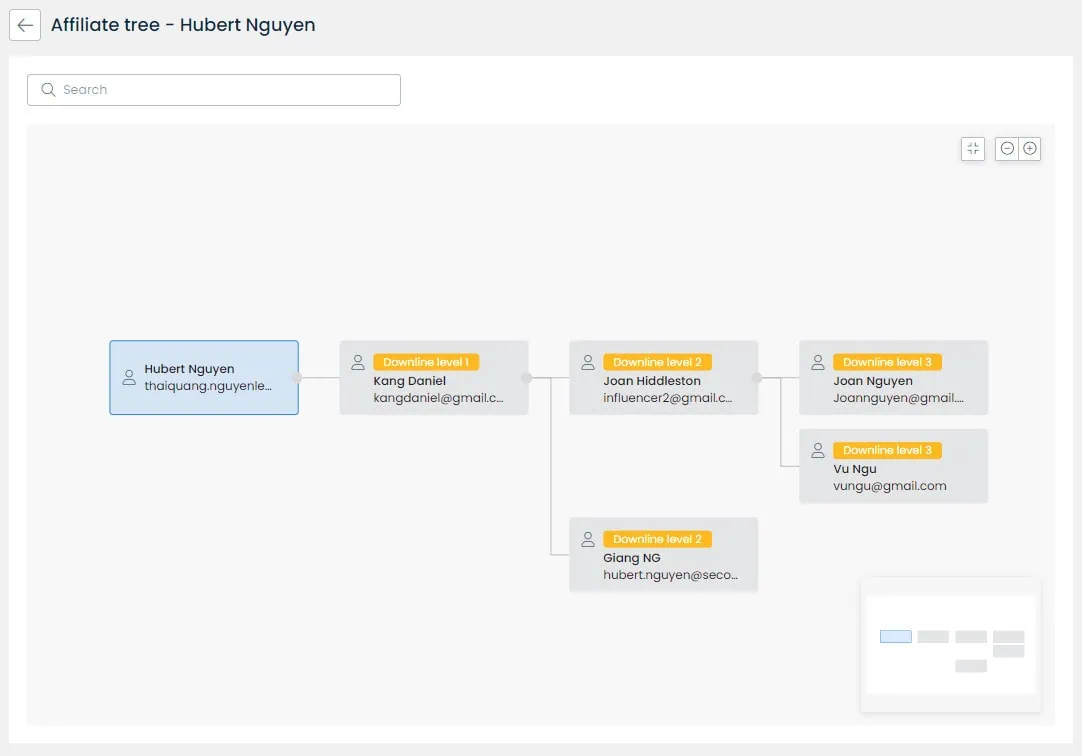
You might wonder how the MLM commissions are displayed with UpPromote.
If a referral order is made by an ambassador in the MLM network, both the original affiliate’s order commission and the upline affiliate’s network commission will appear in the Referral section.
A small note with a “+” will be shown below the original affiliate’s commission, indicating the network commission amount.

Click the eye icon in the Network column. It will show the commissions for all related affiliates, including their levels.

The Bottom Line
Is affiliate marketing multi-level marketing? The answer is no.
Multi-level marketing (MLM) and affiliate marketing are popular ways to grow a business. They work in distinct ways, and sometimes, people are confused about them.
Understanding the differences between affiliate marketing vs MLM is crucial in deciding which model suits your brand. Choosing which one depends on your business goals, resources, and personal preferences.
However, this doesn’t mean you can just choose only one solution for your marketing plan. You can consider combining the strengths of MLM with your affiliate marketing programs to drive more partners and more sales. As long as you have a clear plan and use a powerful affiliate management system like UpPromote for support, it’s totally possible.
UpPromote makes it easy to set up MLM. It will grow your affiliate base without breaking your budget. We also help you effectively manage the publisher team with no hassle.


